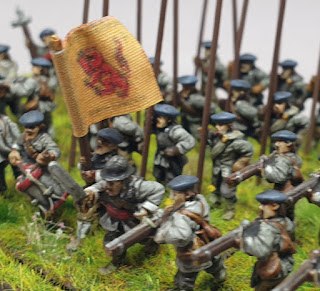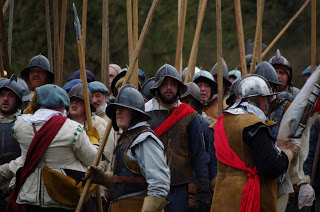The Marquis of Huntly's Regiment of Foot - The Strathbogie Regiment
An interesting regiment this one, changing allegiance on a number of occasions, and regularly being disbanded and raised anew.
The Marquis of Huntly appears to be loyal to himself and himself alone: which ever side was furthering his cause (or whoever was fighting against his personal enemies) would benefit from his sword.
Whilst they were Huntly's Regiment they were that in name only - they were trained and commanded in the field by Lieutenant Colonel William Johnston.
Raised originally to fight in the First Bishop's War in 1639 they would fight at Trot o’Turriff; the battle of Megray Hill; and Brig o’Dee. Huntly managed to get himself imprisoned in April 1639 attempting to broker a peace deal with the Earl of Montrose; he was released from prison and he and his regiment played no part in the Second Bishops' War.
They were raised again in 1644 this time fighting for the King and were present at the taking of Aberdeen; and the storming of Montrose (the town not the Marquis). Feeling that his endeavours were for nought Huntly disbanded the Regiment and returned home.
His son Lord George Gordon would, almost immediately, raise the Regiment again fighting at Fyvie; Dundee; Auldearn; Alford; and Kilsyth. George Gordon would fall in battle at Alford.
The regiment was conventionally equipped with pike and shot, the pikemen wearing armour in 1639. Although there is no evidence that they still wore armour by 1644. The regiment carry one of a number of colours made during their brief occupation of Aberdeen - bearing the Royal Scottish heraldic lion rampant signifying that they fought for the King rather than the country, it is adorned with a suitably rousing motto "for God, the King, and against all traitouris" (which I have adopted as the Army of Montrose casualty marker motto).
The Marquis was an interesting individual - the de facto leader of the Scots Highland Catholics, he was very distrustful of Montrose, believing him to be a turncoat. Montrose would seek Huntly's help after his defeat at Philiphaugh - but the two men quarrelled and were unable to reach an agreement.
When Montrose went into exile, Huntly remained in arms in Banff: the Covenanters moved against him in April 1647 and drove him into the Highlands. He was finally arrested at Strathdon in Aberdeenshire in December and imprisoned at Edinburgh. Already under sentence of death for his seizure of Aberdeen in 1644, Huntly was beheaded in early 1649.
The regiment would continue on, this time under the command of Huntly's third son Lord Lewis Gordon, the 3rd Marquis of Huntly*. They were reincarnated in 1651, this time for the Covenanting army: their history this time being a little less heroic. Ordered to Stirling but instead remained recruiting in northern Scotland; quartered at Rothiemay; finally surrendering to the English in November.
The 3rd Marquis of Huntly was an interesting chap: after the First Bishops' War the teenage Lewis went to France where he enlisted in Louis XIII's army as a pikeman. He wanted to learn the art of war from the ground up. Described as either a great hero or a reckless lunatic he died aged 27 in 1653.
This regiment utilises possibly my favourite pack from the PP range, Scots lowland musketeers, these sculpts have a lot of character and are still some of the best in the range. There's a couple of halberdiers with Scots blew bonnet headswaps. This is my last planned lowland regiment of foot - I certainly won't miss drilling the hands out of the pikemen!
* Some would argue that the hereditary line of the Strathbogie Regiment continued with Colonel William Gordon of Rothiemay's Regiment of Foot rather than with the 3rd Marquis' Regiment. They fought at Worcester where Rothiemay was captured.














Wonderful paint job and interesting historical background...Nice post!
ReplyDeleteThanks for your kind words Phil
Delete